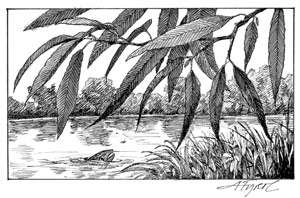
To wildlife biologists, the benefits of maintaining healthy riparian buffers are self-evident. But to most people, these terms are obscure. Riparian comes from the Latin riparius, meaning “bank.” The shores of rivers, streams, and lakes are critical boundaries between uplands and open water. Steep riparian habitats may be only 50 to 100 feet wide, but gently sloping shores along broad lakes and meandering rivers are lined with periodically flooded meadows, swamps, and bogs that can span thousands of feet.
These ecological transition zones form essential habitat for plants and animals, providing food, cover, water, and places for resting, breeding, and raising young. In addition to harboring beaver, mink, muskrat, otter, heron, woodcock, loon, yellow warbler, wood duck, osprey, and others, riparian habitats support an array of plants useful to humans and wildlife alike, including: red and silver maple, green ash, willow, alder, blueberry, cranberry, elderberry, groundnut, boneset, cattail, Joe-Pye weed, and arrowhead.
During spring melting and periods of heavy rain, the plants and soils of riparian wetlands store excess runoff, which then flows slowly into surrounding waters. This reduces flooding overall, allows silt to settle before entering waterways, and decreases peak flood levels. It also decreases the scouring of water and ice along riverbanks. From 50 to 100 percent of sediment settles out and is filtered as runoff passes through the riparian zone. When water meanders through wetlands, it also percolates and recharges groundwater.
Riparian environments act as shields or buffers that protect bodies of water from shoreline disturbances. Soil particles, plant litter, roots, and bacteria absorb 80 to 90 percent of nutrient runoff and pesticides before these enter surface waters and aquifers. Plant roots form mats that bind the soil in place and prevent erosion.
Overhanging branches cast shade that is essential for trout and other cool-water species. Autumn leaves provide food energy for aquatic insects. Fallen tree trunks and branches create habitats for insects, trout, and other wildlife. Flowing water is churned up by these obstacles and enriched with oxygen.
Riparian environments perch precariously between humankind and aquatic ecosystems and are easily disturbed or destroyed. Forestry and construction projects that remove all of the trees can cause shorelines to slump. Plowing up to the water’s edge and grazing animals along the banks create erosion. This is compounded when runoff carries nutrients from manure and fertilizers plus toxins from pesticides. Mowing lawns down to the shoreline eliminates habitat, generates erosion, and allows lawn chemicals to flow directly into the water.
These activities enable waves and currents to remove soil from lakeshores and riverbanks. Silt can bury the gravels of spawning grounds, envelop fish eggs, and coat the gills of fish and aquatic insects, causing stress and suffocation. When shade from overhanging vegetation is removed, water heats up and holds less dissolved oxygen. This creates unfavorable conditions for trout, salmon, and their favorite foods, such as stoneflies. Nutrients that enter waterways from eroded soil and fertilizer runoff increase the growth of algae, which further depletes the supply of oxygen.
Destroying riparian buffers also takes an economic toll. Streams and rivers that flow through denuded shorelines remove tons of soil. Over time, stream channels drift and wash away acres of valuable farmland. Floodwaters rise faster and crest higher—inundating properties downstream and undermining roads and bridge abutments.
What can be done? The solution is simple—laissez faire. Wherever shoreline vegetation already exists, nature will do its job if we just let it be. The Connecticut River Watershed Council recommends maintaining buffers of 50 feet wide to stabilize gradual slopes (100 feet for steep banks); 100 feet to protect fish habitat and filter nutrient runoff and pesticides; 150 feet to control erosion and sediments; 200 feet to mitigate flooding; and 300 to 600 feet for optimal wildlife habitat.
Fences can exclude livestock from riparian habitats. Stream crossings may be limited during forestry operations and erosion minimized by using staked hay bales and silt fences. If a shoreline property has eroded and its habitat degraded, the banks need to be stabilized and buffers restored with native plants.
Landowners can easily find advice, technical expertise, and financial assistance for protecting critical riparian habitat and creating a wise, long-term management plan. Every state’s Natural Resource Conservation Districts offer the Wildlife Habitat Incentives Program (WHIP), Conservation Reserve Program, and Environmental Quality Incentive Program. The U.S. Fish and Wildlife Service runs the Partners for Fish and Wildlife Program, and the U.S. Department of Agriculture provides aid to farmers under the Best Management Practices cost-share program.
In addition to environmental and economic virtues, riparian habitats are prime areas for fishing, boating, swimming, bird watching, and nature photography. They are crucial environments for educational programs and scientific study. And they are of inestimable value to our aesthetic enjoyment of the outdoors and for reconnecting with nature.

